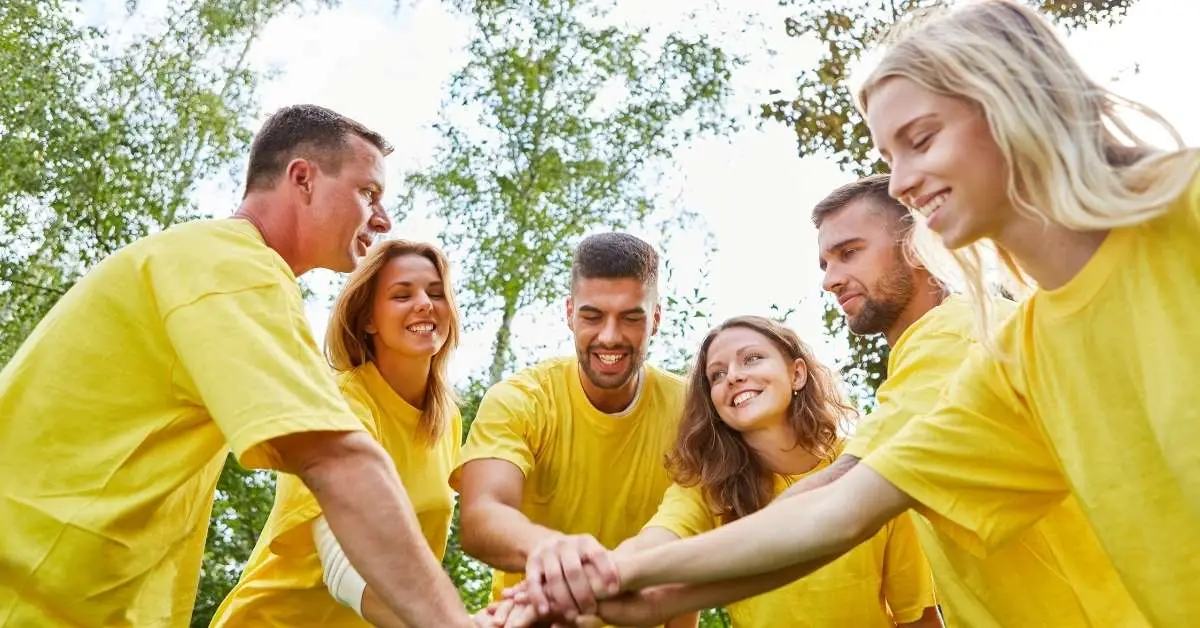
18 Outdoor Team Building Activities That Actually Boost Collaboration
You know that feeling when your team walks outside for an activity and suddenly everyone breathes like they just escaped the Matrix? I’ve felt that too. Something about sunlight and a break from fluorescent office gloom makes people act like real humans again. Outdoor team building hits differently because it shakes everyone out of routine.
When you pick the right activities, your crew actually collaborates instead of pretending to listen. So let me walk you through 18 outdoor team building activities that are used to turn disconnected teams into tight squads.
Key Takeaways
- Explore 18 outdoor team building activities that boost collaboration.
- Know how to choose the best activity for your requirements.
- Discover the best tips for making outdoor team building effective.
1. Relay Races
Relay races look like simple running games, but they work wonders for coordination. Each member completes a section and the team wins only when everyone pulls through. The pressure of passing the baton teaches people to depend on each other and cheer louder than they thought possible.

Why teams love it:
- Encourages support
- Strengthens timing
- Builds trust
- Easy to customize
FYI, dropping the baton becomes a whole team's inside joke for months. But that's exactly the point. These shared moments create the kind of camaraderie you can't force in a conference room.
2. Tug of War
Tug of War sounds simple until everyone takes it personally. You grab the rope, dig your heels in, and hope the other side didn’t skip leg day. Teams quickly realize that brute strength means nothing without timing and coordination.

Benefits:
- Builds unity
- Sparks healthy competitiveness
- Strengthens communication
- Needs minimal equipment and setup time
You learn who motivates and who yells "pull" like a battle commander. The best part? Even the losing team walks away laughing and already planning their comeback strategy.
Pro tip: Mix up teams between rounds so different people work together.
3. Outdoor Obstacle Course
Obstacle courses bring out everyone’s inner kid. Simply, this team building game makes you jump, crawl, climb, and laugh at yourself along the way. The physical challenge breaks down workplace barriers faster than any icebreaker ever could.
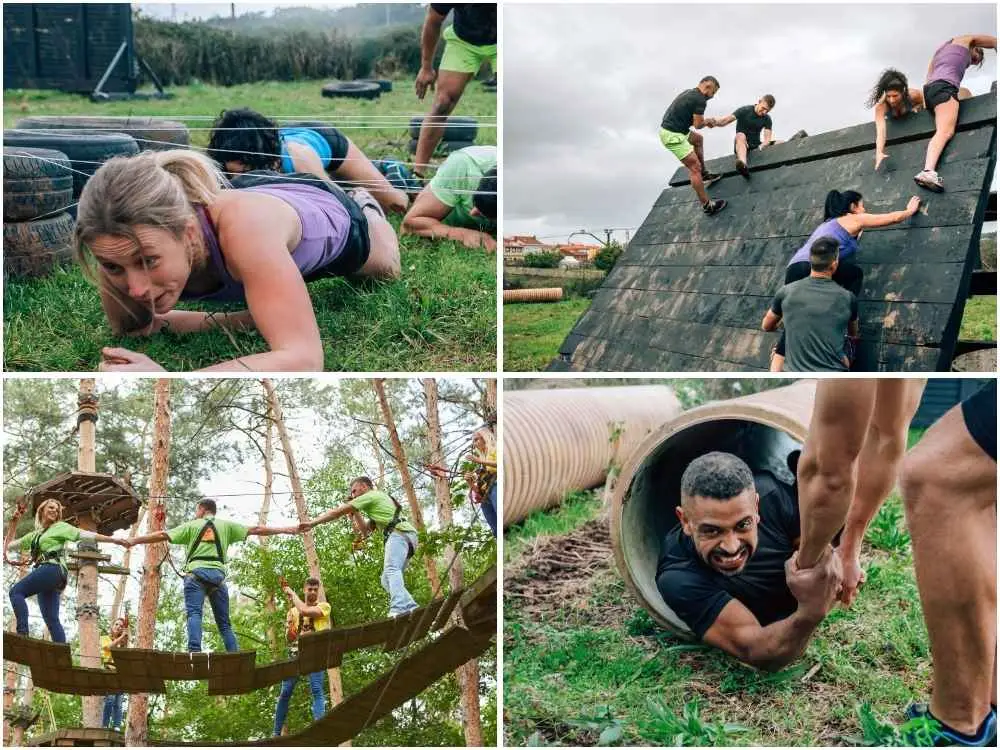
Great for:
- Problem solving
- Group energy
- Adaptability
- Physical ability
Ever notice how teamwork magically improves when mud gets involved? People stop worrying about looking perfect and start focusing on helping each other finish. The shared struggle creates bonds that last long after everyone's cleaned up.
4. Team Sandcastle Building
Near a beach or sand pit? Sandcastle building works surprisingly well. You assign themes and let teams design their masterpieces. Groups quickly divide based on who has the vision and who has the steady hands. The time limit adds pressure that mimics real project deadlines.

Benefits:
- Sparks creativity
- Encourages shared vision
- Builds teamwork organically
People take sand architecture way more seriously than expected. Debates about moat depth and tower placement reveal how teams handle creative differences and compromise. The fragile nature of sand also teaches people to adapt when plans crumble. Plus, everyone walks away with photos of something they built together.
5. Team Picnic Games
Picnic games combine great vibes with teamwork. You mix food with playful games such as sack races, frisbee tosses, water balloon relays, or similar ones.
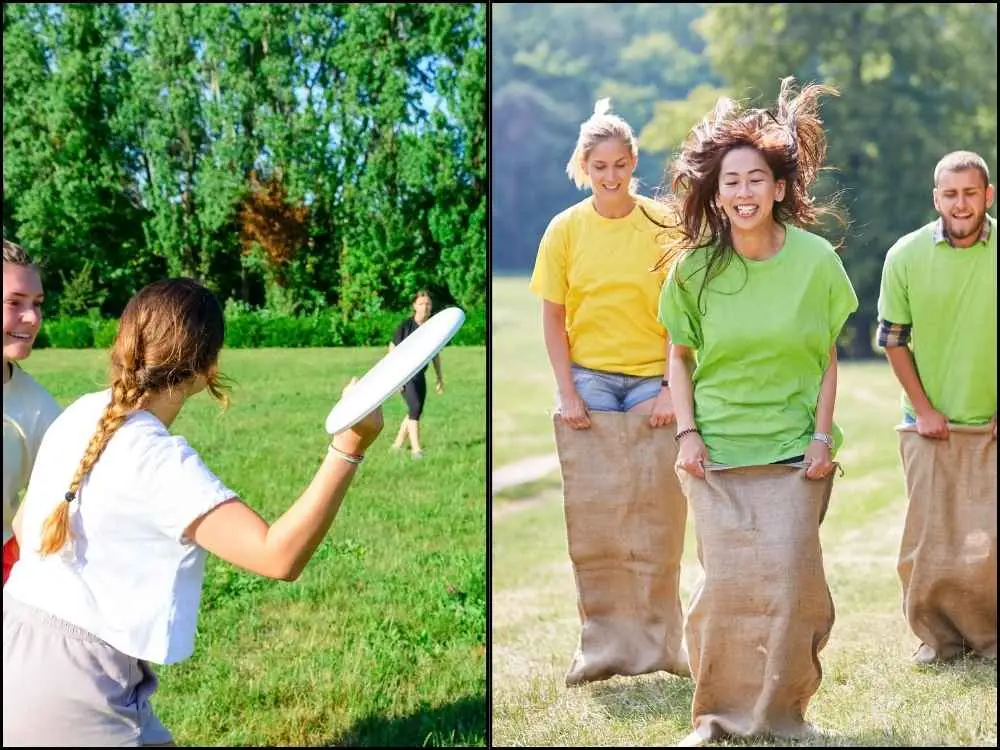
Why it boosts morale:
- Creates casual camaraderie
- Reduces formal pressure
- Encourages natural teamwork
- Flexible format that suits any team size or age range
Food plus games equals an instant good mood. People let their guard down and actually enjoy spending time together. The combination creates positive associations with the team that stick around when you're back at work, tackling deadlines.
6. Nature Walk Conversations
You take the team on a guided walk and pair them for short partner conversations. The change of natural scenery helps everyone open up. People share ideas and stories they'd normally keep to themselves.
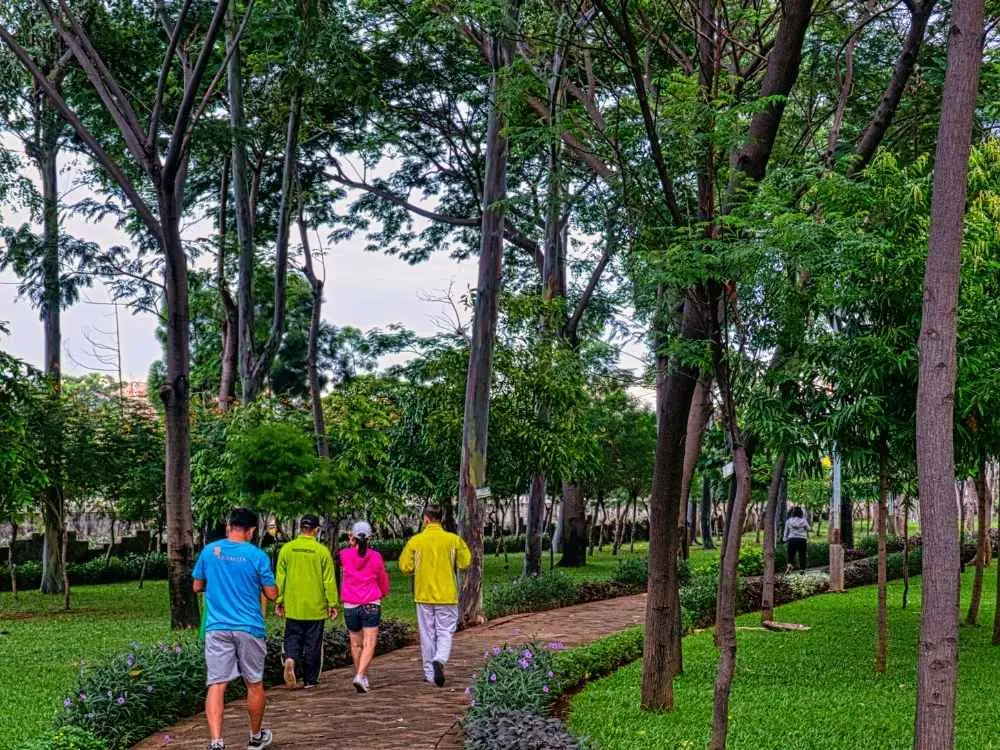
Why it boosts collaboration:
- Reduces stress/anxiety
- Creates natural conversation
- Helps introverts feel included
- Perfect for teams that need low-key bonding time
Ever notice how people talk more freely while moving? The combination of fresh air and gentle activity loosens people up without forcing vulnerability. You'll learn more about your coworkers in thirty minutes of walking than in months of gatherings in the break room.
7. Outdoor Puzzle Stations
You set up puzzle challenges around an outdoor area. Teams travel from station to station solving tasks before they advance. Each puzzle requires different skills, so the math person shines at one stop while the creative thinker dominates another. Everyone gets their moment to contribute something valuable to the group.
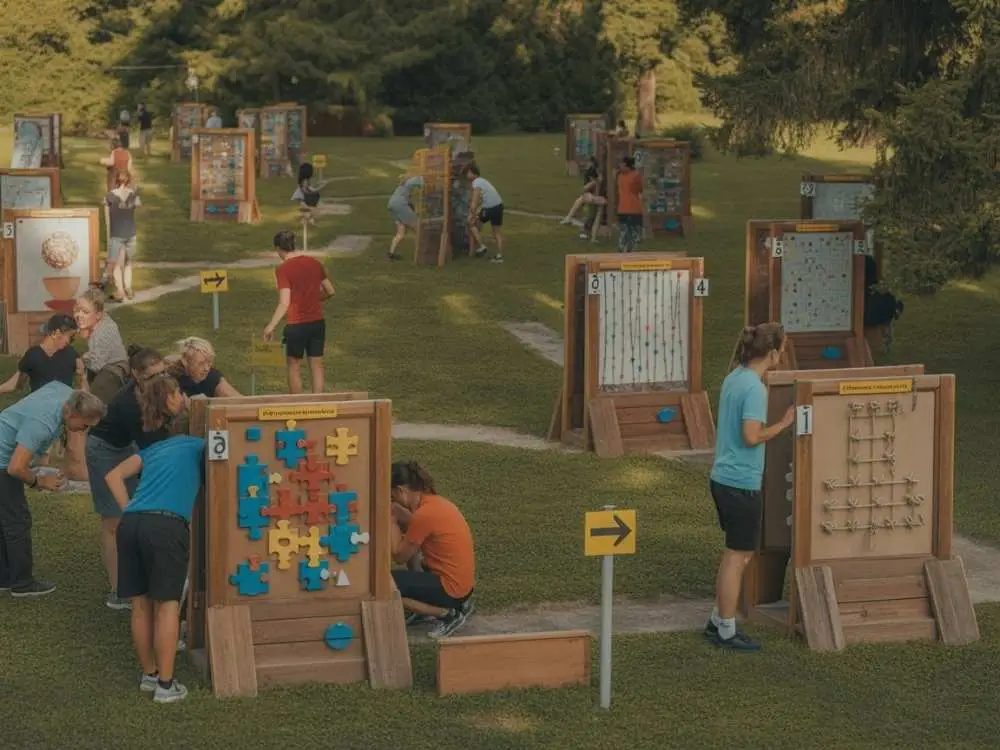
What it strengthens:
- Critical thinking
- Group decision making
- Task coordination
Puzzles feel different when sunlight hits your face instead of a monitor. The outdoor setting keeps energy high while teams debate solutions and test theories. Plus, the movement between stations prevents that stuck feeling when a problem gets tough.
8. Geocaching Challenge
You use GPS coordinates to find hidden caches around a park or open space. Teams strategize to cover ground faster. Some members handle navigation while others decode clues and plan the most efficient route.

Strengthens:
- Navigation skills
- Collaboration
- Group problem solving
- Combines tech skills with outdoor adventure
IMO, this geocaching game feels like outdoor treasure hunting for adults. The thrill of discovery gets everyone engaged, even the skeptics who thought they'd hate being outside. Teams celebrate together when they crack a tough location, and those small victories build momentum.
9. Giant Jenga Tournament
You bring a giant outdoor Jenga set and form teams. Let everyone strategize like the tower controls their destiny. Teams debate which block to pull and where to place it.

Why it works:
- Encourages patience and perseverance
- Strengthens focus
- Promotes shared strategy
- Requires minimal space
The tower always collapses at the most dramatic moment. But here's what's interesting. Teams learn to handle pressure together and make group decisions under stress. The groans when it falls and the celebrations when it holds teach people how to win and lose as a unit.
10. Capture the Flag
Capture the Flag gets competitive in the best way. You run, hide, plan, protect, and hope someone on your team actually pays attention. The chaos forces people to communicate clearly or watch their flag disappear.
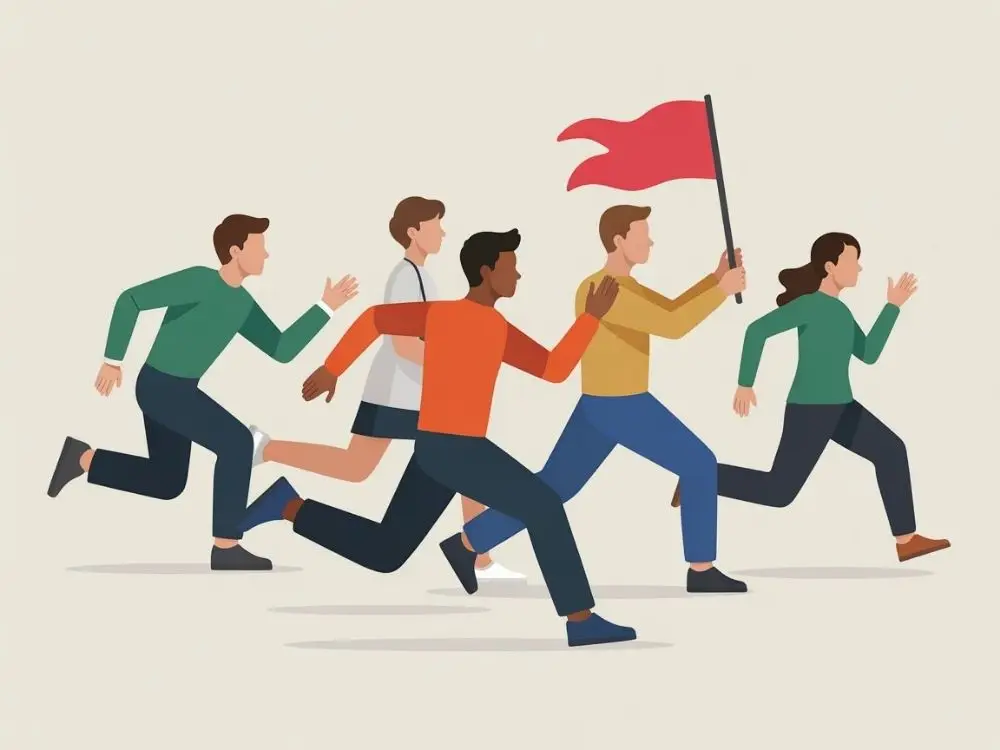
Benefits:
- Builds communication
- Encourages planning
- Strengthens quick decision-making
- Works best with larger teams in open spaces
Ever see your teammates turn into undercover spies? Hilarious and effective. The game reveals natural leaders and shows who thrives under pressure. Plus, the post-game debriefs, where everyone shares their perspective that create genuine learning moments about teamwork and strategy.
11. Outdoor Brain Teaser Trail
You set up written riddles or tasks along a walking trail. Teams solve clues to continue moving forward. Each riddle unlocks the next location, so nobody rushes ahead without bringing the whole group along. The format naturally prevents anyone from dominating since different brains crack different types of puzzles.
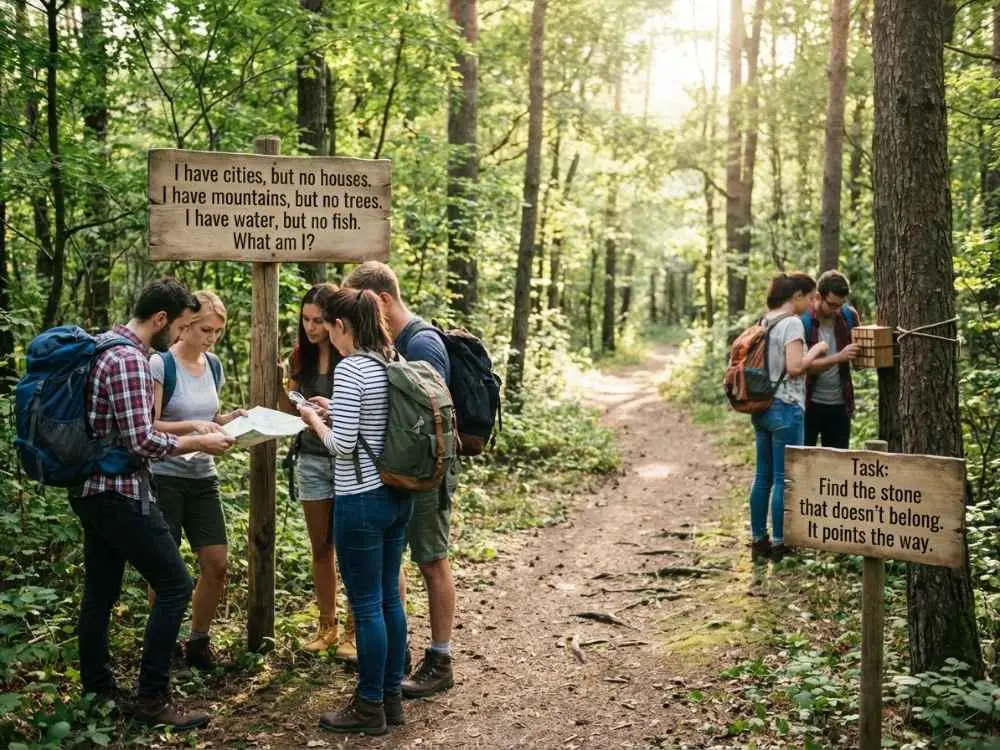
Why it builds collaboration:
- Requires combined strengths
- Encourages logical discussion
- Great for teams who prefer mental over physical challenges
- Promotes group pacing
Ever notice that one teammate who solves riddles like they’re psychic? Always good to have them around. But the real value shows when the team learns to leverage everyone's thinking style. The person who struggles with wordplay might nail the logic puzzle that stumped everyone else.
12. Water Balloon Challenge
Water balloon activities sound childish but teams love them. You can play toss-and-catch, target throws, obstacle challenges, or similar innovative games. Teams coordinate timing and distance while trying not to soak themselves too early. The inevitable splashes break down any remaining professional stiffness and get everyone laughing at the absurdity of it all.

Good for:
- Coordination
- warm weather
- Group laughter
- Stress relief
Just prepare backups because water balloons love to explode early. The messy chaos creates a level playing field where the CEO gets just as wet as the intern. Bring towels and plan this activity toward the end so nobody sits uncomfortable afterward.
13. Scavenger Hunt Adventure
Scavenger hunts get people moving, thinking, and occasionally sprinting like the prize is pure gold. You split the team with relevant team names, hand them a list of tasks or items, and let the fun chaos begin.

Why it boosts collaboration:
- Encourages strategy discussions
- Requires delegation
- Forces real teamwork
- Works for any group size and fitness level
Ever watch someone refuse to quit until they find a leaf shaped like a heart? It’s fantastic. The competitive energy brings out problem-solving skills you didn't know your quiet coworker had.
14. Trust Fall Circle
Trust falls still exist. And yes, they still work. You stand in a circle, one person falls back, and the group catches them. You get the nervousness before that first fall, but the relief and laughter afterward actually matter.

Why it's important:
- Builds emotional trust
- Promotes reliability
- Encourages vulnerability
- Improve teamwork
People bond fast when everyone swears they won't let each other hit the ground. The quiet person from accounting suddenly becomes someone you trust completely. That shift in perspective carries back to the office when projects get stressful.
15. Outdoor Escape Game
Outdoor escape games combine scavenger hunt vibes with puzzle solving. You follow clues across an area to uncover the final code or location. Teams split responsibilities naturally as some people excel at riddles while others spot hidden details that everyone else missed.
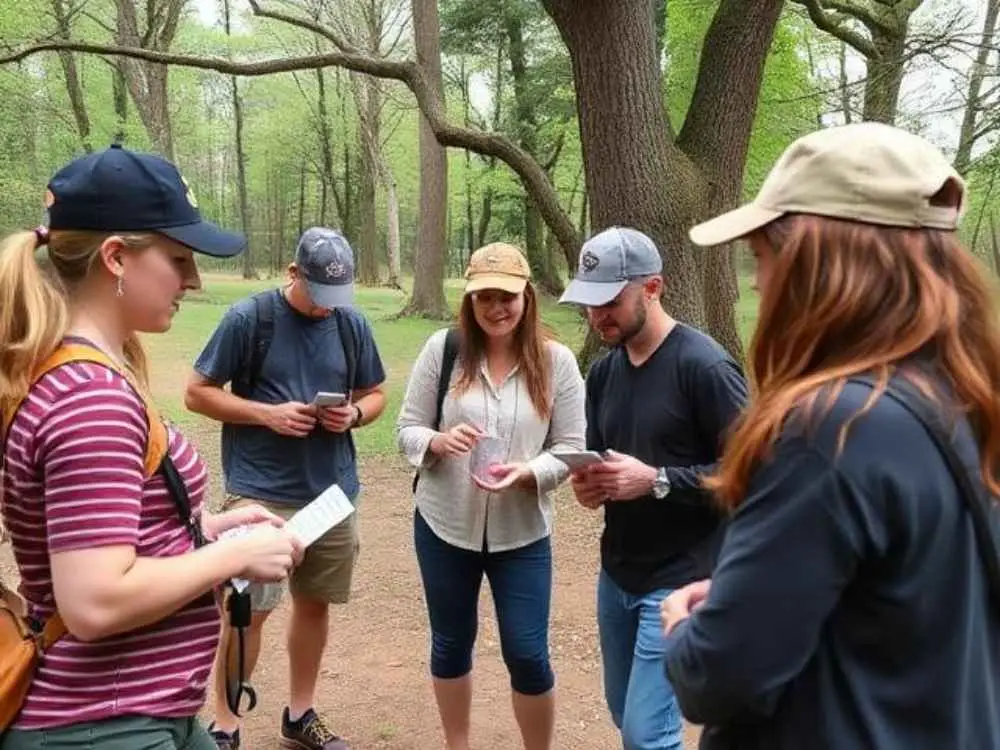
Why it’s powerful:
- Builds joint problem-solving
- Encourages distributed tasks
- Scalable difficulty keeps all experience levels engaged
- Enhances leadership moments
Ever feel like your team just entered a real-life mystery movie? Exactly. The immersive experience pulls people out of their usual roles and lets new dynamics emerge. Someone quiet might take charge when they crack a crucial clue, showing leadership skills that office meetings never revealed.
16. Line Formation Challenge
The team must line up by birthdays, heights, experience, or other metrics without speaking. Doing this outside adds movement and unpredictability. People develop hand signals and find creative ways to communicate information without words. The frustration of being misunderstood quickly turns into laughter and determination.

Why it boosts collaboration:
- Requires zero equipment and works anywhere outdoors
- Strengthens nonverbal communication
- Encourages teamwork
- Improves observation skills
Watching people mime their birthdays never gets old. But beyond the entertainment, teams learn that communication goes deeper than words. They discover who pays attention to details and who naturally helps others understand.
17. Parachute Games
You bring one of those giant parachutes everyone loved in school. Teams lift, rotate, bounce balls, or create waves together. Success depends entirely on everyone moving in rhythm and responding to the group's energy. One person out of sync and the whole thing collapses, which teaches timing better than any PowerPoint ever could.
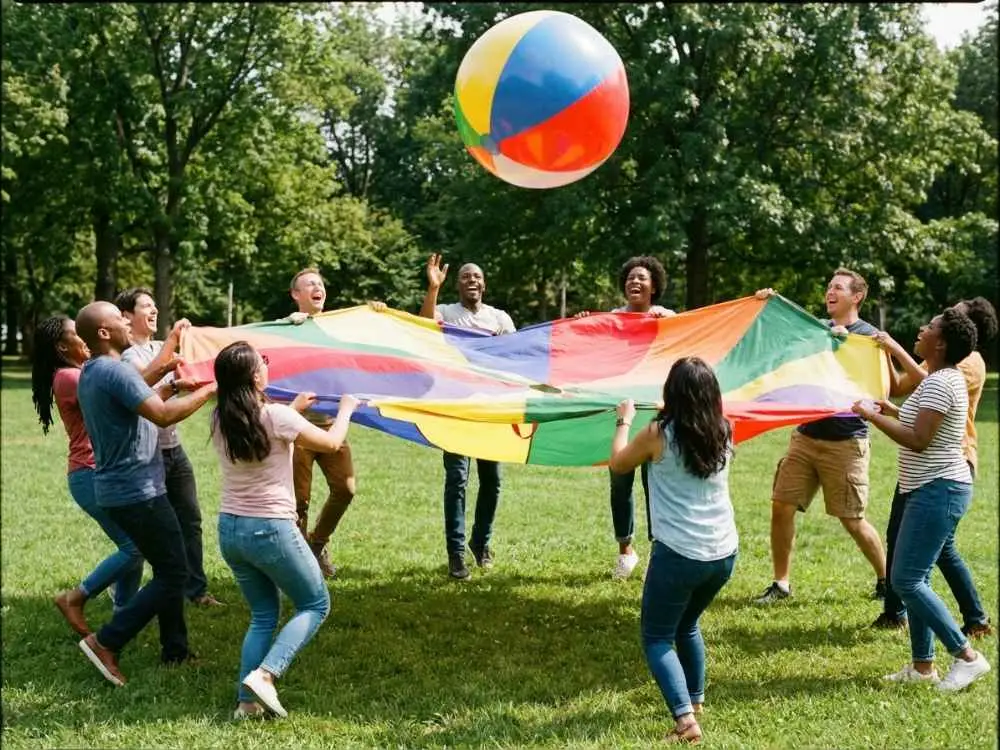
Why it works for adults too:
- Builds group coordination
- Promotes synchronized movement
- Encourages shared excitement
Nobody touches a parachute without smiling. It's science. The childhood memories flood back and suddenly everyone's playful again. That emotional shift opens people up to collaborating without overthinking it. The physical act of holding something together becomes a perfect metaphor for how teams actually function.
18. Team Photo Challenge
Your team receives themes and must take creative photos together. Themes can range from "Most Dramatic Scene" to "Unusual Landmark Pose." Teams brainstorm concepts and direct each other like amateur film crews. The planning process gets everyone contributing ideas and builds excitement before the actual photo happens.
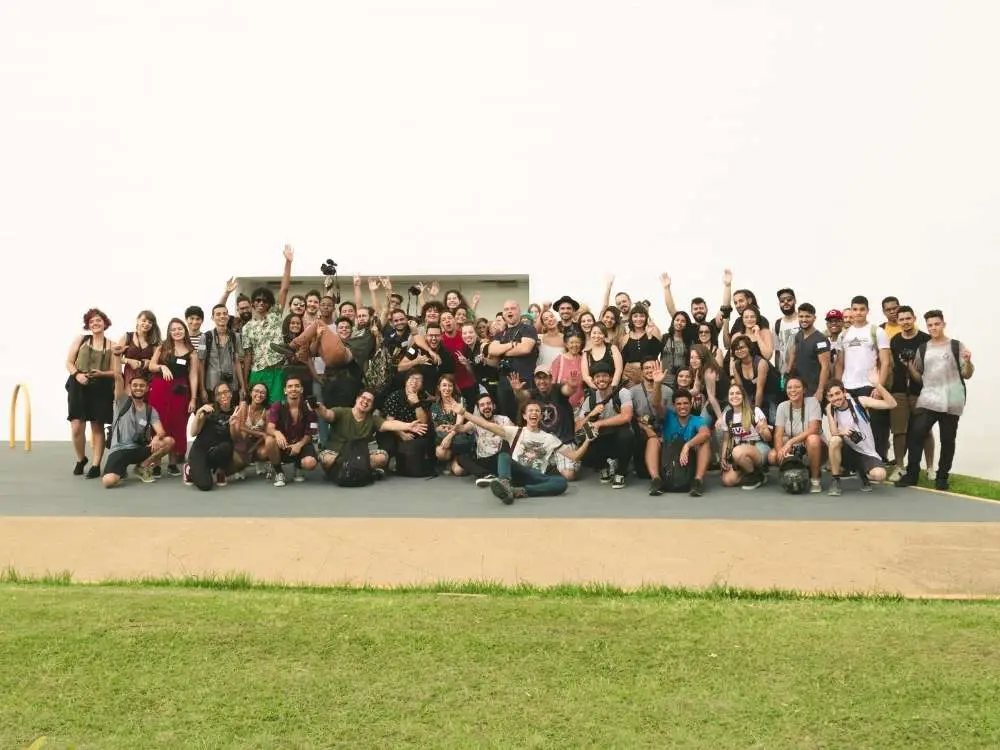
Why it strengthens teams:
- Boosts creativity
- Encourages bonding
- Creates hilarious memories
Some of the best team photos come from these challenges. The shared laughter during awkward poses and failed attempts creates inside jokes that last for years. Plus, teams end up with tangible proof of their collaboration that they'll actually want to look at later, unlike most corporate team building evidence.
How to Choose the Right Outdoor Activity
Outdoor activities feel fun by default. However, picking the right ones still matters. You don’t want to choose high-intensity games for a team that just wants a calm afternoon.
Consider:
- Group energy levels and preferences
- Physical comfort and ability
- Space available for activities
- Weather conditions that day
- Time limits and schedules
- Accessibility for all members
I always check the vibe before committing. Saves everyone from awkward moments or unnecessary workouts. A quick survey or casual conversation reveals whether your team craves competition or connection.
Tips for Making Outdoor Team Building Effective
Outdoor environments already help collaboration, but you can boost the impact even more with the right approach.
Try these:
- Keep instructions simple
- Pair different personality types
- Encourage shared leadership
- Celebrate both wins and fails
- Reflect briefly afterward
- Allow everyone to participate comfortably
Ever notice how outdoor activities feel less intimidating when people can read the room? The same rule applies here.
Wrapping Up
Outdoor team building is helpful to bring teams closer in a way that indoor meetings never can. When people share real experiences, collaboration becomes natural. You can try a few of these 18 outdoor team building activities and see how well your team responds. You might see new leaders emerge and communication flow better.
FAQs
Q1: How long should outdoor team building activities last?
Most activities work best between one to three hours. Anything shorter may feel rushed and anything longer exhausts people. So pay attention to energy levels and wrap up while everyone's still having fun.
Q2: What if some team members can't participate in physical activities?
Always offer alternatives or choose activities everyone can do. The goal is inclusion, not athleticism. A team building activity that excludes people defeats the entire purpose of bringing everyone together.
Explore Related Posts
https://smarttoolsai.com/post/indoor-team-building-games
https://smarttoolsai.com/post/virtual-team-building-activities
https://smarttoolsai.com/post/examples-of-effective-team-dynamics
.webp)